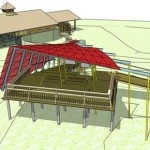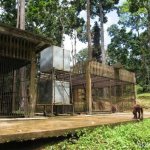Sunbears and Vegetarians
Photos by Sue Chong-Hartley, Text by Ian Hall
“We need an ayam jantan bertaji, don’t forget the taji. Taji is important!” Sue instructed me. At first she had asked Wai Pak to help find the cockerel but as a conscientious Buddhist he didn’t want to be complicit in killing an animal.
Normally the supply of sacrificial cockerels is not one of my professional services but I liked the idea of the story that I could tell afterward.
The Taji is the heel spur or claw that you only find on cockerels; they are an important weapon in cock fights and as such can cause controversy when unscrupulous owners apply poison to the taji of their prized fighters.
In this case the taji was important for the power it bestowed to a traditional Kadazan ritual for cleansing the ground for a new building, in this case our new sun bear conservation centre. The Mongimpi is performed by Kadazan priestesses known as bobohizan in their own language.
The three elderly female bobohizan and their young male apprentice who performed the groundbreaking ceremony are the last of their kind in Sabah. It is not just sun bears that are endangered.
Perhaps if there was more work for bobohizans it might tempt young people into the career and help conserve the culture?
Perhaps one reason that young people are not becoming bobohizan is the increasing distance between urban culture and nature?
Many in the audience at the Mongimpi would not be applying for the job and they expressed distress and distaste at the sight of a healthy cockerel having its throat slit.
This was the first time I had witnessed a sacrifice and I did not find the event as violent as I had imagined. Throughout the preamble the cockerel was quiescent in the hands of the bobohizan. When it’s time came the knife was almost gentle and there was not a squawk, although there was an awkward moment a minute or two later when it tried to come back to life again. ‘Headless chickens’ and all that.
For me what was more upsetting was the condition that I found chickens being kept in when I was looking for the cockerel. The beautiful animal that was sacrificed was provided by a friend of a friend and came direct from a free-range life in a village, happily calling in each day and feeding on whatever distasteful waste was chucked out the back doors.
The animals that I saw lived in cramped squalor, feathers were missing, water and food was mouldy, sun shading inadequate and dead birds were strewn on the floor. Apart from the glaring animal welfare issue, it gave me nightmares about what my food looked like before I eat it.
For the first time in my life I have found myself choosing vegetarian dishes on grounds of principle rather than taste or social obligation. Not that I will be giving up the bacon butties any time soon but I’ll remember the cockerel.
Other people around the Mongimpi circle may believe that the ritual death of an animal is unnecessary. I think it was worthwhile even if only to remind us to treat nature with respect.
Furthermore, I am delighted to hear that the bobohizan reported that the ceremony had been a success and that the offering had been accepted and understood.
Related posts







That was the first time I met bobohizan and attent their ritual. I agree with you that every culture needs to conserve. Many of the young kadazan duzun people even don’t know how to speak thier own langguage.
Pingback: Sunbears and Vegetarians | Bornean Sun Bear Conservation
Pingback: BSBCC Construction Photo Diary | Arkitrek